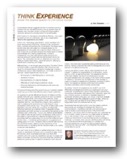Think EXPERIENCE
16/09/10 Filed in: Leadership Articles

Conventional wisdom suggests we live in a service economy, evolved from an industrial economy, having evolved from an agrarian one. Success comes to those providing excellent customer service at a winning level of price and quality.
Don’t count on it. Go beyond conventional thinking. If you want to stand out and win customers, ask of your organization, What is the experience we create?
Here’s why. Technology, globalization, and a relentless 24/7 pace have pushed productivity, lowered prices, and turned many products and services into commodities. But these same factors have also stimulated an increased desire to find expressions of individuality and meaning. Much of the world has moved into a post-service economy where value is created by knowledge and creating experiences. In today’s marketplace, you need right-priced quality products and services along with great customer service just to be in the game. The businesses that win our attention are those that meet our higher-level needs – personal attention, belonging, identification, meaning, and image.
Melinda Davis, in her thought-provoking book The New Culture of Desire makes a case that seeking ‘bliss’ will be the new driver for consumer buying decisions. Increasingly in today’s marketplace, people seek experiences, not simply products or services. Valued experiences may include:
- Belonging to an identified group or community;
- Symbols of status;
- Representations of a desired lifestyle;
- Affirmations of self-image or personal values;
- Personal relationships with the people with whom we conduct business.
Innovative thinking about the experience your business creates could lead you to the most effective way to reach customers.
An experience can be defined as the sum of interactions that people have with your business combined to form a coherent and meaningful whole in the mind of the customer. Case example: Starbucks makes excellent coffee, with friendly and expedient service – but where the company really cashed in was in marketing the experience of a daily dose of luxury accessible to the common soul. The growth of Starbucks is now legendary, and their stores are ubiquitous. As Starbucks becomes identified as a national chain, independent shops everywhere gain their success by contrasting themselves as the authentic local coffee shop - Cup-A-Joe*, Weaver Street Market, and Caffe Driade are just some of the fabulous coffee spots in this writer’s local environment. Meanwhile Starbucks is now promoting itself as a great place not only for the coffee but also for the music – in short the place for an experience of getting away from it all. The lesson here is that for both national and local businesses, attention to the experience of the business plays a marketing role far beyond simple price, quality, or service considerations.
You don’t have to be a national or global enterprise in order to create an experience that gives you a competitive edge. Quite the reverse, small businesses and sole proprietors that carefully craft their customer experience can gain an edge over larger companies. My favorite local wine shop, Hillsborough Wine Company, has more than competitive prices and good service - they excel at making customers feel both knowledgeable about wine and part of a special community. In spite of competition from national chains, they have seen substantial sales growth.
Just as size doesn’t matter, asking “what experience do we create?” is relevant to organizations from all sectors - public and non-profit, as well as business. The experience that my small town creates has enormous influence on tourism, economic development, and quality of life. Much of the success of Habitat for Humanity can be attributed to their strategy of creating a hands-on experience of physically working to build a home - an experience shared by the new home owners, individual volunteers, and corporate donors alike.
By asking, “what is the experience we create?” you think differently and deeply about both your organization and your customers. Answering the question fully requires meaningfully connecting multi-faceted associations that customers make with your industry, product, or service to important aspects of customers’ emotions, thoughts, and values. Important: answer the question from the customer’s point of view, otherwise your thinking won’t go beyond simply listing what your organization does for customer service and quality. (see a related 7 Ideas Coach Podcast)
Businesses that are intentional in how they create customer experiences are relentless in shaping their behaviors, communications, marketing materials, and surroundings in order to evoke a personal experience in the mind of the customer. If you simply think of what you offer you customers as a mix of price, quality, or service, you might easily be missing out on real success. In fact, you might be unintentionally creating an experience of your business as simply average or mediocre. In contrast, when you are intentional about delivering your products and services packaged in a creative and coherent experience, you give yourself a powerful edge to maximize the value you offer – and therefore the value that comes back to you.
* Cup-A-Joe as mentioned in a NYT op-ed article by novelist Lee Smith
***
by Tom Stevens (c)2010
Tom Stevens helps leaders create and sustain exceptional organizations. To contact him, visit www.ThinkLeadershipIdeas.com
This article may be freely reprinted in your company, association, or publication (or website) under the following terms: that the author attribution, copyright notice, contact information, and this reprint notice be included; and that you inform us that you are using the article (samples appreciated).

THINK! Subscribers received this leadership article in PDF - FREE
You can too! Get this article immediately when you subscribe...get articles now
blog comments powered by Disqus
